高中英语新课标必修三_Unit_1教案
- 格式:doc
- 大小:62.50 KB
- 文档页数:7
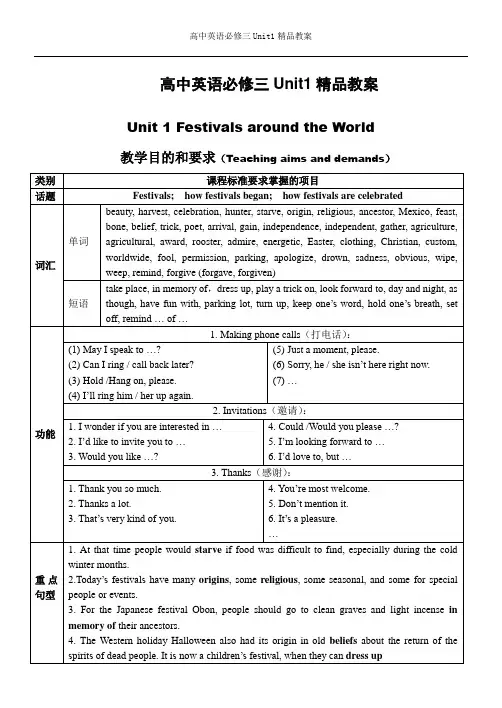
高中英语必修三Unit1精品教案Unit 1 Festivals around the World 教学目的和要求(Teaching aims and demands)Period 1 Warming up & pre-readingDate: _________________ Name:___________________Teaching targets:Knowledge and ability objectives:1.To learn about festivals in different parts of the world and compare them2.To get more words about festivals and customs3.To talk about festivals and express ideas by using the wordsStrategy objectives:By means of task-based language teaching, students can participate in pair and group work to get more information about festivals around the world and think more about the topic Moral objectives: By comparing and contrasting the cultures in China and other countries, students can understand the cultural differences between countries, show respect for other culture and customs andlove Chinese culture.Important points:To talk about the festivals around the worldDifficult points:To know about the reasons for the celebrationsTeaching aids :MultimediaTeaching procedure:Task 1 BrainstormingWork in groups and list below Chinese festivals or holidays that you know.Chinese festivals & Holidays:1.Spring Festival2. The Lantern Festival3. Tomb Sweeping Day4.The Dragon Boat Festival5.The Double Seventh Festival6.The Mid-Autumn Festival7.The Double Ninth Festival8.New Year’s Day(元旦)9.International Women’s Day 10.International Labour Day11.Childre n’s Day12.National Day……Task 2 BrainstormingWork in groups and list below Western festivals that you know.Western festivals:1.Valentine’s Day2.Easter(Mar--April)3.April Fool’s Day4.Mother’s Day (in May)5.Father’s Day (June)6.Halloween (Oct.31)7.Thanksgiving Day (November)8.Christmas9. 10. ……Task 3: DiscussionFestivals are meant to celebrate important times of year. Then work in groups to discuss about when they take place, what they celebrate and what people do at that time.Task 4: Reading《三维设计》P2。
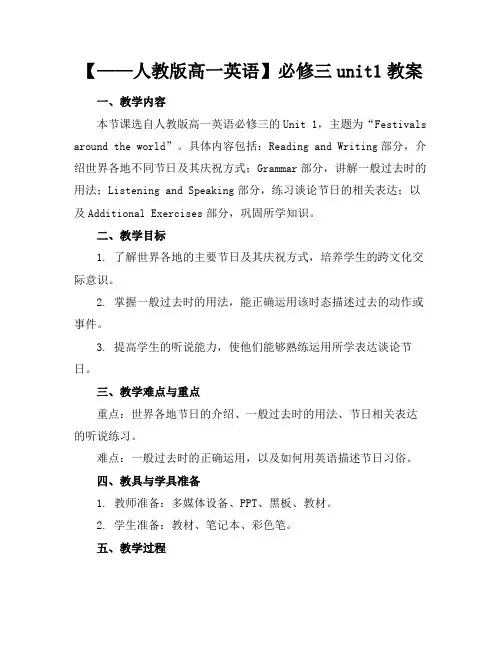
【——人教版高一英语】必修三unit1教案一、教学内容本节课选自人教版高一英语必修三的Unit 1,主题为“Festivals around the world”。
具体内容包括:Reading and Writing部分,介绍世界各地不同节日及其庆祝方式;Grammar部分,讲解一般过去时的用法;Listening and Speaking部分,练习谈论节日的相关表达;以及Additional Exercises部分,巩固所学知识。
二、教学目标1. 了解世界各地的主要节日及其庆祝方式,培养学生的跨文化交际意识。
2. 掌握一般过去时的用法,能正确运用该时态描述过去的动作或事件。
3. 提高学生的听说能力,使他们能够熟练运用所学表达谈论节日。
三、教学难点与重点重点:世界各地节日的介绍、一般过去时的用法、节日相关表达的听说练习。
难点:一般过去时的正确运用,以及如何用英语描述节日习俗。
四、教具与学具准备1. 教师准备:多媒体设备、PPT、黑板、教材。
2. 学生准备:教材、笔记本、彩色笔。
五、教学过程1. 导入:通过播放一段关于世界各地的节日视频,激发学生的兴趣,引入本节课的主题。
2. 阅读与写作:a. 让学生快速浏览课文,了解世界各地的主要节日。
c. 指导学生进行写作练习,用一般过去时描述自己最喜欢的节日。
3. 语法讲解:通过例句和练习,让学生掌握一般过去时的用法。
4. 听力与口语:a. 播放听力材料,让学生回答关于节日的问题。
b. 学生两人一组,进行节日话题的口语练习。
5. 巩固练习:完成Additional Exercises部分,检查学生对本节课知识的掌握。
六、板书设计1. Festivals around the world2. 内容:a. 世界各地节日及庆祝方式b. 一般过去时的用法c. 节日相关表达七、作业设计1. 作业题目:a. 根据课文内容,用一般过去时描述一个你了解的节日。
b. 收集更多关于节日的资料,与同学分享。
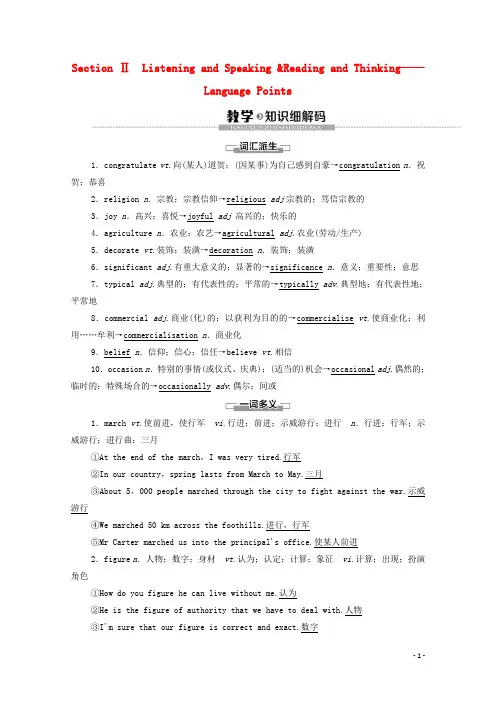
Section ⅡListening and Speaking &Reading and Thinking——Language Points1.congratulate vt.向(某人)道贺;(因某事)为自己感到自豪→congratulation n.祝贺;恭喜2.religion n.宗教;宗教信仰→religious adj宗教的;笃信宗教的3.joy n.高兴;喜悦→joyful adj高兴的;快乐的4.agriculture n.农业;农艺→agricultural adj.农业(劳动/生产)5.decorate vt.装饰;装潢→decoration n.装饰;装潢6.significant adj.有重大意义的;显著的→significance n.意义;重要性;意思7.typical adj.典型的;有代表性的;平常的→typically adv.典型地;有代表性地;平常地8.commercial adj.商业(化)的;以获利为目的的→commercialise vt.使商业化;利用……牟利→commercialisation n.商业化9.belief n.信仰;信心;信任→believe vt.相信10.occasion n.特别的事情(或仪式、庆典);(适当的)机会→occasional adj.偶然的;临时的;特殊场合的→occasionally adv.偶尔;间或1.march vt.使前进,使行军vi.行进;前进;示威游行;进行n.行进;行军;示威游行;进行曲;三月①At the end of the march,I was very tired.行军②In our country,spring lasts from March to May.三月③About 5,000 people marched through the city to fight against the war.示威游行④We marched 50 km across the foothills.进行,行军⑤Mr Carter marched us into the principal's office.使某人前进2.figure n.人物;数字;身材vt.认为;认定;计算;象征vi.计算;出现;扮演角色①How do you figure he can live without me.认为②He is the figure of authority that we have to deal with.人物③I'm sure that our figure is correct and exact.数字④She's always had a good figure.身材⑤I hadn't figured on getting home so late.计算、算到⑥I can't figure out how to do this.弄懂Words And Phrases知识要点1 congratulation n .祝贺;恭喜(教材P 2)receive congratulations from...收到来自……的祝贺[例1] I want to express my sincere congratulations on your success. 我想对你的成功表示诚挚的祝贺。
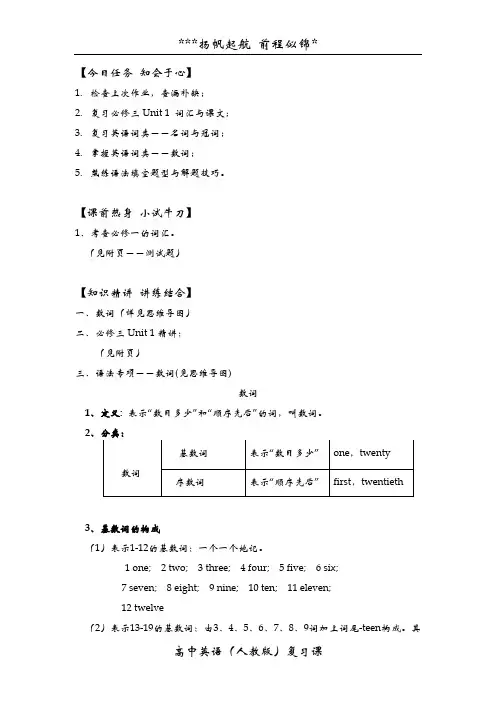
【今日任务知会于心】1.检查上次作业,查漏补缺;2.复习必修三Unit 1 词汇与课文;3.复习英语词类——名词与冠词;4.掌握英语词类——数词;5.熟练语法填空题型与解题技巧。
【课前热身小试牛刀】1、考查必修一的词汇。
(见附页——测试题)【知识精讲讲练结合】一、数词(详见思维导图)二、必修三Unit 1精讲:(见附页)三、语法专项——数词(见思维导图)数词1、定义:表示“数目多少”和“顺序先后”的词,叫数词。
23、基数词的构成(1)表示1-12的基数词:一个一个地记。
1 one;2 two;3 three;4 four;5 five;6 six;7 seven; 8 eight; 9 nine; 10 ten; 11 eleven;12 twelve(2)表示13-19的基数词:由3、4、5、6、7、8、9词加上词尾-teen构成。
其中-teen表示ten。
*13= thirteen (thir=three)14=fourteen*15=fifteen (fif=five)16=sixteen17=seventeen*18=eighteen (eigh=eight)19=nineteen(3)表示“整十”的基数词:由2、3、4、5、6、7、8、9的基数词加上词尾-ty构成。
其中-ty表示ten。
*20 twen ty (twen-=two)*30thir ty(thir--=three)*40for ty(for-=four)*50 fif ty (fif-=five)60 six ty70 seven ty*80 eigh ty (eight-=eight)90 nine ty(4)表示“带零头”的两位数。
eg. 21,35, 46, 57,63, 74, 85, 98等。
构成模式:表示“整十”的基数词+ 连字符+ 表示1-9的基数词整十零头例如:21=20+1=twenty-one 35=30+5=thirty-five46=40+6=forty-six 57=50+7=fifty-seven69=60+9=sixty-nine 72=70+2=seventy-two87=80+7=eighty-seven 98=90+8=ninety-eight(5)表示“三位数以上”的基数词。
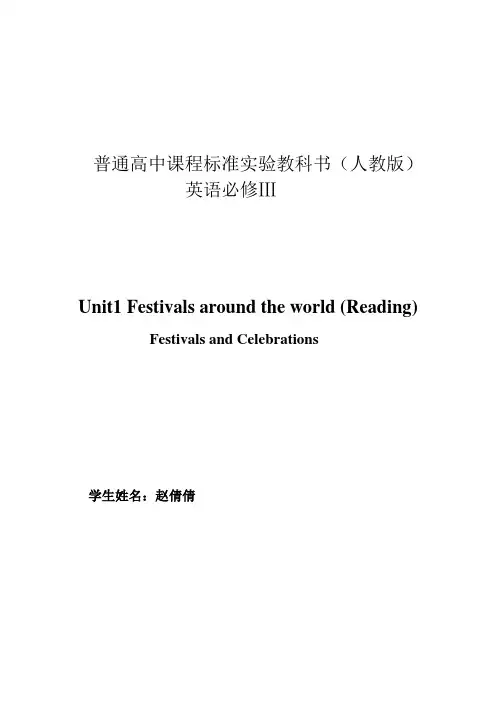
普通高中课程标准实验教科书(人教版)英语必修ⅢUnit1 Festivals around the world (Reading) Festivals and Celebrations学生姓名:***Unit 1Festivals around the worldⅠ.Analysis of teaching materialAt the beginning of the class, the teacher can lead in the topic of the unit by having a free talk with students about their winter holidays and the Spring Festival.The Warming Up is intended to have students start thinking about the variety of events and festivals that are celebrated in China, and connect them with seasons of the year and reasons for the celebrations. The teacher can use this part to introduce information that Chinese students should have about their country’s cultural events.The Pre-reading is a continuation of the Warming Up and it moves the discussion to a more personal level. It is intended to help students enter imaginatively into a discussion of festivals and their importance to the society. It also directs their attention to the variety of events and activities those festivals include. The teacher should let students discuss the questions and predict what kind of information will be introduced in the Reading.The reading passage titled FESTIV ALS AND CELEBRATIONS briefly describes the earliest kinds of festivals with the reasons for them, and then four different kinds of festivals that occur in most parts of the world. Encourage students to look at the pictures and the heading of each section to guess what the text might be about. Then let them skim for the general idea for each section, and scan for further understanding. Because this passage introduces a lot of useful new words and expressions which are only used for festivals, in order not to let students feel much difficult, the teacher should deal with any language problems while they are reading. After reading, students are required to do the four exercises in the Comprehending to see how much they have understood the reading passage. The teacher can first let them work in pairs or in groups to find the answers cooperatively, and then check their answers with the whole class.To consolidate the contents of the reading passage, students should be required to talk about festivals in their own words at the end of the class. In order to arouse students’ interest, the teacher can hold a competition between groups.Ⅱ.Teaching aims1.Knowledge aims1). Get students to learn the useful new words and expressions in this part: beauty, harvest, starve, origin, religious, ancestor, Mexico, feast, bone, belief, poet, arrival, gain, independence, gather, agriculture, award, rooster, admire, energetic, Easter, clothing, Christian, custom, take place, in memory of, dress up, play a trick on, look forward to, day and night, as though, have fun with2). Let students learn about history and basic knowledge of festivals both in and out of China.2.Ability aims1). Develop students’ reading ability and let them learn different reading skills.2). Enable students to talk about festivals and celebrations.3.Emotional aims1). Stimulate students’ love for their own national culture and customs.2). Develop students’ sense of cooperative learning.Ⅲ.Teaching methods:1. Explanation to get the students to have a clear idea.2. Discussion to get the students to understand the text easier.Ⅳ.Teaching Aids:A computer and a tape recorderⅤ.Teaching important and difficult points1. Important points1). Let students learn more about history and basic knowledge of festivals.2). Get students to learn different reading skills.2. Difficult points1). Devel op students’ reading ability.2). Enable students to talk about festivals and celebrations.Ⅵ.Teaching procedure→Step 1 Leading-inHave a free talk with students. Ask them the following questions:Did you have a good time in your winter holidays?When did you feel most happy and excited? Why?(At the Spring Festival. Because it’s the most important festival in our country. . . )→Step 2 Warming up1. Let students brainstorm the other Chinese festivals.(Lantern Festival, Pure Brightness Festival, Dragon Boat Festival, Mid-Autumn Festival, New Year’s Day, Chung Yeung Festival. . . )2. Let students read the information about Chinese festivals below and discussanother three Chinese festivals:When does the festival come?What do people celebrate?What do people do?Festivals Date Festivals DateNew Year January 1st Teachers’ Day September 10th InternationalWomen’s DayMarch 8th National Day October 1stArbor Day March 12th The Spring Festival Lunar New YearInternational Labor Day May 1st Dragon BoatFestivalthe fifth day of the fifthlunar monthInternational Children’s Day June 1st Mid-AutumnFestivalthe 15th day of the 8thlunar monthArmy Day August 1st Lantern Festival the 15th day of the 1stlunar monthChinese Youth Day May 4th Pure BrightnessDayApril the fifth3. Ask students to fill in the following form and ask some to share their opinions with the whole class. The first one is given as an example.Festivals Time of year/date What it celebrates What people doMid-Autumn Festival autumn/fall the beauty of thefull moon, harvest,time with familyand friendsgive/eat mooncakes and watchthe full moon withfamily and friends4. Talk about some foreign festivals with students.(Christmas, April Fools’ Day, Easter, Halloween, Valentine’s Day, Thanksgiving Day, . . . )→Step 3 Pre-reading1. Let students discuss the following questions:What festivals or celebrations do you have in your city or town? What part of a festival do you like best—the activities, the music, the sights, the food or the people who visit?2. Ask students to look at the pictures and title of the passage in Reading. Discuss inpairs what kind of information will be introduced in the passage.→Step 4 Reading1. Fast readingAsk students to skim the reading passage and then fill in the following chart. Kinds of Festivals Names of Festivals CountriesFestivalsFestivalsHarvestSpring(Let students look through the chart and then read the text silently. Three minutes later, check the answers with the whole class. Show the suggested answers on the screen. )2. Intensive readingAllow students to read carefully this time to understand the main ideas of each paragraph and the important details, and then finish the following:1)Choose the best answer to each question or to finish each sentence according tothe text.(1)Why do Japanese people light lamps during the Festival of the Dead?A. Because they want to make the festival colorful.B. Because they want to light up their rooms.C. Because they want to light up their way.D. Because they want to lead their ancestors to return to earth.(2)Which of the following was not mentioned as a famous person in the text?A. Mohandas Gandi.B. Christopher Columbus.C. Abraham Lincoln.D. Qu Yuan.(3)The place where people will usually decorate churches and town halls withflowers and fruits is ______________.A. IndiaB. AmericaC. EuropeD. China(4)Easter is held in memory of the return of Jesus for Christians and also celebrates______________.A. the coming of springB. the autumn harvestC. the Lunar New YearD. the end of a yearSuggested answers: (1)D(2)C(3)C(4)A2)Use the information from the reading passage to answer the following questions.(1)What are festivals of the dead usually for?(2)What makes autumn festivals happy events?(3)What do people usually do at spring festivals?(4)What is one important reason to have festivals and celebrations?(5)Compare the festivals of the dead in Mexico, Japan and China. What things are similar? What things are different?3. Reading and discussionRead the text a third time and then work in pairs to do the following.1)Based on the reading passage, what do most festivals seem to have in common?Why do you think these things might be important to people everywhere? Talk with your partner and fill in the chart below.Three common things Reasons why they are important to people everywhere1.2.3.2)Discuss in pairs which festivals you think are the most important and which are the most fun. Then fill in the chart with your ideas.Type of festival Example of festival Reasons for yourchoiceMost importantMost fun(Let students have enough time to read the passage carefully and discuss the questions and charts with their partners. Encourage them to expand their answers according to their own experiences. )4. ExplanationHelp students analyze some difficult, long and complex sentences and guess the meanings of some new words. Encourage them to try to deal with the language points in the context.Discuss the following important sentences and phrases in the passage.1) Some festivals are held to honour the dead, or to satisfy the ancestors, who mightreturn either to help or to do harm.2) In memory of3) India has a national festival on October 2 to honour Mohandas Gandhi, the leaderwho helped gain India’s independence from Britain.4) People are grateful because their food is gathered for the winter and theagricultural work is over.5) The most energetic and important festivals are the ones that look forward to theend of winter and to the coming of spring.6) The country, covered with cherry tree flowers, looks as though it is covered withpink snow.Suggested explanations:1)The sentence contains a non-restrictive attributive clause who might return eitherto help or to do harm. It means people hold some festivals either to show respect to the dead or to make their ancestors happy in case they might come back to do harm.2)I n memory of: serving to recall sb. , to keep him fresh in people’s mindsHe wrote a poem in memory of his dearest wife, who died in an accident.in honor of: showing great respect or high public regard3)T he leader who helped gain India’s independence from Britain: a noun phrasefollowed by an attributive clause as the appositive4)two clauses for reason5)energy n. → energetic adj. : full of or done with energylook forward to: “to” is a preposition here.I’m looking forward to hearing from you.be devoted to; be/get used to; get down to; stick to. . .6)covered with cherry tree flowers: a past participle phrase equal to “which iscovered with cherry tree flowers”as though: as ifHe talks as though he knew all about it.He looks as if he had seen a ghost.5. Reading aloud and underliningAsk students to read the passage aloud to the tape and let them pay attention to the pronunciation of each new word and the pauses within each sentence. Tell them to pick out all the useful expressions or collocations from the passage while reading and copy them to the notebook after class as homework.→Step 5 ConsolidationAsk students to talk about festivals in their own words according to the text.Then let them complete the following passage with proper words or phrases.There are all kinds of festivals and ______________ around the world, which are held for different ______________. The ancient festivals were mainly held at three times a year—the end of the cold ______________, planting in spring and ______________ in autumn. Some festivals are held to ______________ the dead or ______________ the ancestors, who might return either to help or ______________, while other festivals are held to honor famous people or to the ______________, such as Dragon Boat Festival, Columbus Day, and so on. Harvest and ______________ festivals are happy events because their food is ______________ for the winter and the ______________ work is over, to which Mid Autumn Festival belongs. And the most ______________ and important festivals are the ones that ______________ the end of winter and to the coming of ______________ such as the Lunar New Year, at which people have a very ______________.Suggested answers: celebrations; reasons; weather; harvest; honor; to satisfy; to do harm; gods; Thanksgiving; gathered; agricultural; energetic; look forward to;spring; good time→Step 6 Homework1)Preview the next part about reading to get the main idea.2) Translate these sentences into English:(People usually do at the Spring Festival)1 大扫除迎新年的到来。
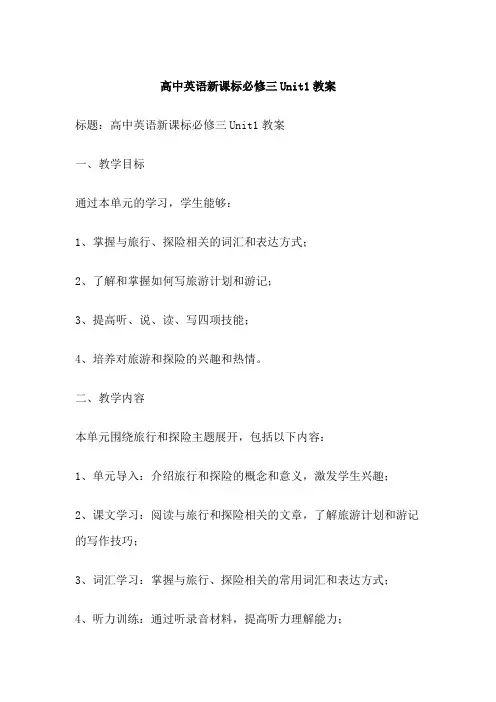
高中英语新课标必修三Unit1教案标题:高中英语新课标必修三Unit1教案一、教学目标通过本单元的学习,学生能够:1、掌握与旅行、探险相关的词汇和表达方式;2、了解和掌握如何写旅游计划和游记;3、提高听、说、读、写四项技能;4、培养对旅游和探险的兴趣和热情。
二、教学内容本单元围绕旅行和探险主题展开,包括以下内容:1、单元导入:介绍旅行和探险的概念和意义,激发学生兴趣;2、课文学习:阅读与旅行和探险相关的文章,了解旅游计划和游记的写作技巧;3、词汇学习:掌握与旅行、探险相关的常用词汇和表达方式;4、听力训练:通过听录音材料,提高听力理解能力;5、口语练习:通过小组讨论、角色扮演等活动,提高口语表达能力;6、阅读理解:阅读与旅行和探险相关的文章,提高阅读理解能力;7、写作训练:根据所学内容,写一篇旅游计划或游记。
三、教学过程1、单元导入:通过展示一些美丽的旅游景点图片,引导学生谈论旅行和探险的意义和价值,激发学生兴趣。
2、课文学习:通过多媒体设备,展示课文内容,引导学生阅读和理解。
在阅读过程中,教师可适当解释生词和难句,帮助学生理解文章。
3、词汇学习:通过讲解、示范、例句等方式,帮助学生掌握本单元的词汇和表达方式。
4、听力训练:播放与旅行和探险相关的录音材料,让学生听并做听力理解练习。
教师可适当解释生词和难句,帮助学生理解。
5、口语练习:通过小组讨论、角色扮演等活动,让学生练习口语表达。
教师可适当引导和纠正。
6、阅读理解:根据本单元主题,选取相应文章进行阅读理解练习。
教师可适当解释生词和难句,帮助学生理解。
7、写作训练:根据所学内容,让学生写一篇旅游计划或游记。
教师可适当指导和纠正。
四、教学评估1、通过课堂表现、作业、测验等方式,对学生的学习情况进行评估;2、通过小组讨论、角色扮演等活动,对学生的口语表达能力进行评估;3、通过写作练习,对学生的写作能力进行评估。
五、教学反思根据学生的学习情况和其他反馈,对本次教学进行反思和总结,以便更好地指导今后的教学工作。
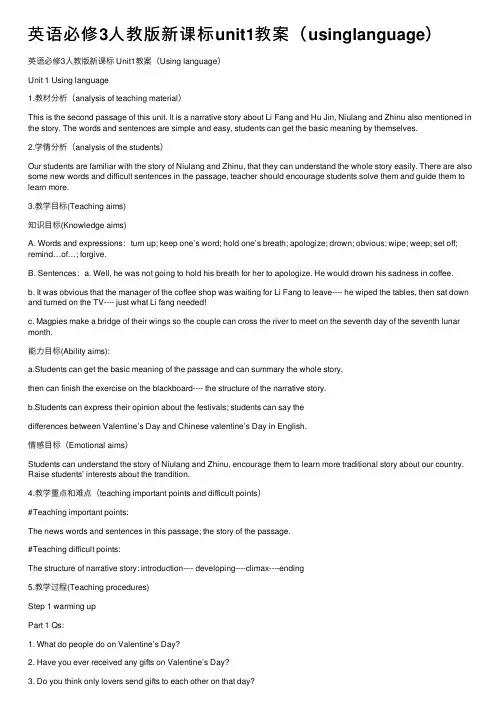
英语必修3⼈教版新课标unit1教案(usinglanguage)英语必修3⼈教版新课标 Unit1教案(Using language)Unit 1 Using language1.教材分析(analysis of teaching material)This is the second passage of this unit. It is a narrative story about Li Fang and Hu Jin, Niulang and Zhinu also mentioned in the story. The words and sentences are simple and easy, students can get the basic meaning by themselves.2.学情分析(analysis of the students)Our students are familiar with the story of Niulang and Zhinu, that they can understand the whole story easily. There are also some new words and difficult sentences in the passage, teacher should encourage students solve them and guide them to learn more.3.教学⽬标(Teaching aims)知识⽬标(Knowledge aims)A. Words and expressions:turn up; keep one’s word; hold one’s breath; apologize; drown; obvious; wipe; weep; set off; remind…of…; forgive.B. Sentences:a. Well, he was not going to hold his breath for her to apologize. He would drown his sadness in coffee.b. It was obvious that the manager of the coffee shop was waiting for Li Fang to leave---- he wiped the tables, then sat down and turned on the TV---- just what Li fang needed!c. Magpies make a bridge of their wings so the couple can cross the river to meet on the seventh day of the seventh lunar month.能⼒⽬标(Ability aims):a.Students can get the basic meaning of the passage and can summary the whole story,then can finish the exercise on the blackboard---- the structure of the narrative story.b.Students can express their opinion about the festivals; students can say thedifferences between Valentine’s Day and Chinese valentine’s Day in English.情感⽬标(Emotional aims)Students can understand the story of Niulang and Zhinu, encourage them to learn more traditional story about our country. Raise students’ interests about the trandition.4.教学重点和难点(teaching important points and difficult points)#Teaching important points:The news words and sentences in this passage; the story of the passage.#Teaching difficult points:The structure of narrative story: introduction---- developing----climax----ending5.教学过程(Teaching procedures)Step 1 warming upPart 1 Qs:1. What do people do on Valentine’s Day?2. Have you ever received any gifts on Valentine’s Day?3. Do you think only lovers send gifts to each other on that day?Part 2 : Do we have our own Valentine’s Day in China?Qiqiaojie (乞巧节) ---- the seventh day of the seventh lunar monthWell-known poem: Eternal love between us two, Shall withstand the time apart (两情若是久长时,⼜岂在朝朝暮暮。
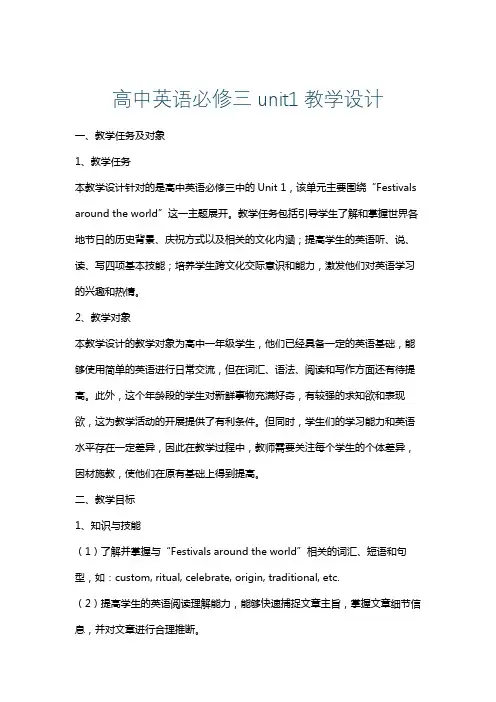
高中英语必修三unit1教学设计一、教学任务及对象1、教学任务本教学设计针对的是高中英语必修三中的Unit 1,该单元主要围绕“Festivals around the world”这一主题展开。
教学任务包括引导学生了解和掌握世界各地节日的历史背景、庆祝方式以及相关的文化内涵;提高学生的英语听、说、读、写四项基本技能;培养学生跨文化交际意识和能力,激发他们对英语学习的兴趣和热情。
2、教学对象本教学设计的教学对象为高中一年级学生,他们已经具备一定的英语基础,能够使用简单的英语进行日常交流,但在词汇、语法、阅读和写作方面还有待提高。
此外,这个年龄段的学生对新鲜事物充满好奇,有较强的求知欲和表现欲,这为教学活动的开展提供了有利条件。
但同时,学生们的学习能力和英语水平存在一定差异,因此在教学过程中,教师需要关注每个学生的个体差异,因材施教,使他们在原有基础上得到提高。
二、教学目标1、知识与技能(1)了解并掌握与“Festivals around the world”相关的词汇、短语和句型,如:custom, ritual, celebrate, origin, traditional, etc.(2)提高学生的英语阅读理解能力,能够快速捕捉文章主旨,掌握文章细节信息,并对文章进行合理推断。
(3)培养学生的英语听力技巧,能听懂关于世界各地节日的英语对话和短文,提高获取关键信息的准确性。
(4)提高学生的英语口语表达能力,能够运用所学知识进行关于节日的讨论和交流,发表自己的观点和看法。
(5)锻炼学生的英语写作能力,能撰写关于节日的小短文,介绍节日的起源、庆祝活动等。
2、过程与方法(1)通过小组合作、讨论、分享等方式,让学生在互动交流中学习英语,提高他们的合作能力和沟通能力。
(2)运用多媒体教学资源,如视频、图片、音频等,为学生提供丰富的教学情境,激发学生的学习兴趣。
(3)采用任务型教学法,引导学生完成各种听说读写任务,提高学生的实际运用能力。
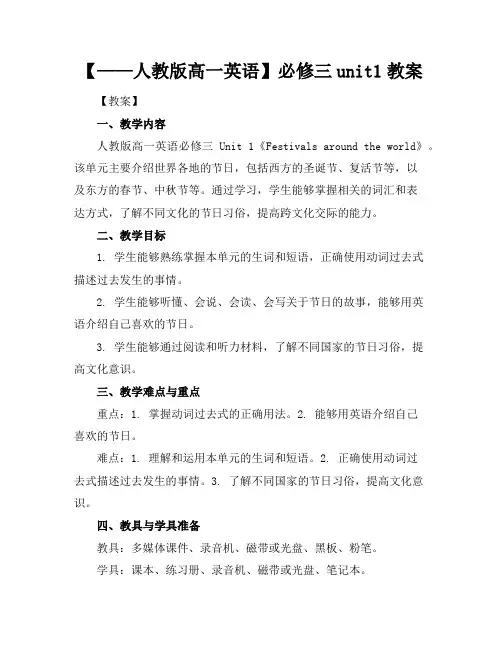
【——人教版高一英语】必修三unit1教案【教案】一、教学内容人教版高一英语必修三Unit 1《Festivals around the world》。
该单元主要介绍世界各地的节日,包括西方的圣诞节、复活节等,以及东方的春节、中秋节等。
通过学习,学生能够掌握相关的词汇和表达方式,了解不同文化的节日习俗,提高跨文化交际的能力。
二、教学目标1. 学生能够熟练掌握本单元的生词和短语,正确使用动词过去式描述过去发生的事情。
2. 学生能够听懂、会说、会读、会写关于节日的故事,能够用英语介绍自己喜欢的节日。
3. 学生能够通过阅读和听力材料,了解不同国家的节日习俗,提高文化意识。
三、教学难点与重点重点:1. 掌握动词过去式的正确用法。
2. 能够用英语介绍自己喜欢的节日。
难点:1. 理解和运用本单元的生词和短语。
2. 正确使用动词过去式描述过去发生的事情。
3. 了解不同国家的节日习俗,提高文化意识。
四、教具与学具准备教具:多媒体课件、录音机、磁带或光盘、黑板、粉笔。
学具:课本、练习册、录音机、磁带或光盘、笔记本。
五、教学过程1. 情景引入(5分钟)教师通过向学生提问:“你们最喜欢的节日是什么?为什么?”来引出本课的主题。
学生可以自由发言,分享自己喜欢的节日和原因。
教师引导学生用英语进行表达,同时板书关键词“festival”和“celebrate”。
2. 课堂讲解(15分钟)教师带领学生学习本课的生词和短语,如“Christmas”、“Easter”、“Spring Festival”等,并通过例句解释其用法。
接着,教师讲解动词过去式的正确用法,并通过练习题让学生进行随堂练习。
3. 听力训练(10分钟)教师播放课文中的听力材料,学生边听边做练习。
听力材料内容包括不同国家的节日习俗。
听后,教师提问学生关于听力材料的问题,检查学生对听力内容的理解。
4. 阅读理解(10分钟)教师分发课文阅读材料,学生独立阅读,并回答相关问题。
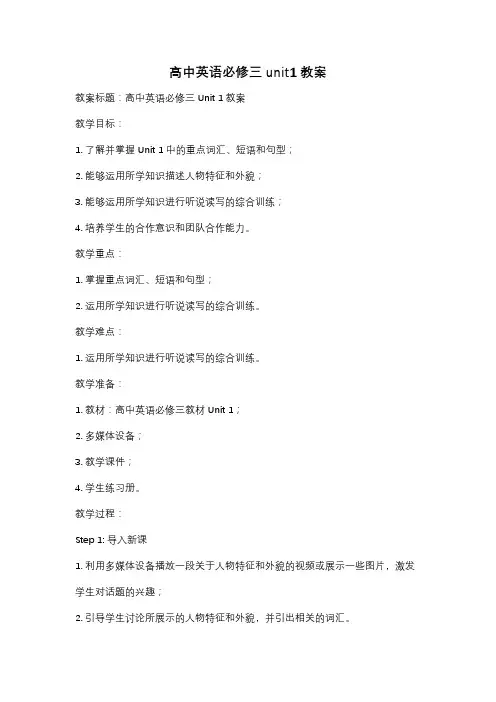
高中英语必修三unit1教案教案标题:高中英语必修三Unit 1教案教学目标:1. 了解并掌握Unit 1中的重点词汇、短语和句型;2. 能够运用所学知识描述人物特征和外貌;3. 能够运用所学知识进行听说读写的综合训练;4. 培养学生的合作意识和团队合作能力。
教学重点:1. 掌握重点词汇、短语和句型;2. 运用所学知识进行听说读写的综合训练。
教学难点:1. 运用所学知识进行听说读写的综合训练。
教学准备:1. 教材:高中英语必修三教材Unit 1;2. 多媒体设备;3. 教学课件;4. 学生练习册。
教学过程:Step 1: 导入新课1. 利用多媒体设备播放一段关于人物特征和外貌的视频或展示一些图片,激发学生对话题的兴趣;2. 引导学生讨论所展示的人物特征和外貌,并引出相关的词汇。
Step 2: 词汇学习1. 教师呈现并讲解Unit 1中的重点词汇,包括形容词、名词和动词;2. 学生跟读并模仿教师的发音;3. 学生进行词汇拓展活动,如根据给出的词根或词缀构造新词。
Step 3: 句型学习1. 教师呈现并讲解Unit 1中的重点句型,包括描述人物特征和外貌的句型;2. 学生进行句型操练活动,如根据给出的句子结构进行句子变换。
Step 4: 听说读写综合训练1. 教师设计听力活动,如听力填空或听力选择题,让学生通过听力理解并掌握所学知识;2. 学生进行口语练习,如两人一组描述对方的外貌特征;3. 学生进行阅读活动,如阅读课文并回答相关问题;4. 学生进行写作活动,如根据所给的人物描述写一篇短文。
Step 5: 合作学习1. 学生分组进行合作学习,如小组讨论和合作完成一些任务;2. 教师进行指导和辅导,鼓励学生积极参与合作学习。
Step 6: 总结和评价1. 教师对本节课的教学进行总结,强调重点和难点;2. 学生进行自我评价,反思自己在本节课中的学习情况和问题。
Step 7: 作业布置1. 布置课后作业,如完成练习册上的相关练习;2. 鼓励学生积极参加课外阅读,拓展自己的词汇和语言能力。
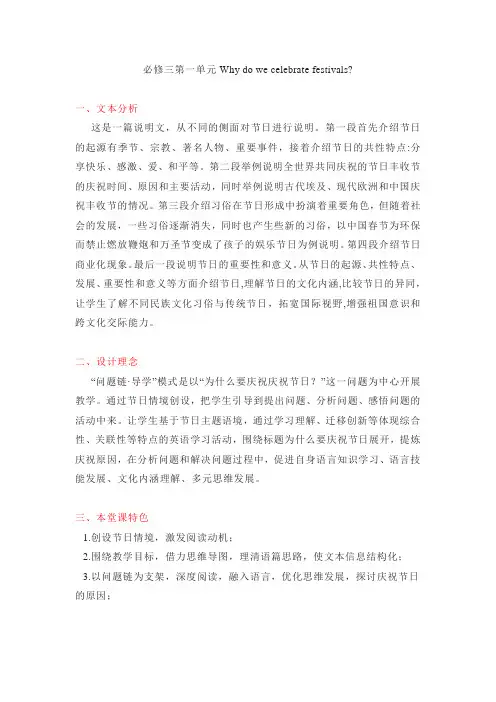
必修三第一单元Why do we celebrate festivals?一、文本分析这是一篇说明文,从不同的侧面对节日进行说明。
第一段首先介绍节日的起源有季节、宗教、著名人物、重要事件,接着介绍节日的共性特点:分享快乐、感激、爱、和平等。
第二段举例说明全世界共同庆祝的节日丰收节的庆祝时间、原因和主要活动,同时举例说明古代埃及、现代欧洲和中国庆祝丰收节的情况。
第三段介绍习俗在节日形成中扮演着重要角色,但随着社会的发展,一些习俗逐渐消失,同时也产生些新的习俗,以中国春节为环保而禁止燃放鞭炮和万圣节变成了孩子的娱乐节日为例说明。
第四段介绍节日商业化现象。
最后一段说明节日的重要性和意义。
从节日的起源、共性特点、发展、重要性和意义等方面介绍节日,理解节日的文化内涵,比较节日的异同,让学生了解不同民族文化习俗与传统节日,拓宽国际视野,增强祖国意识和跨文化交际能力。
二、设计理念“问题链·导学”模式是以“为什么要庆祝庆祝节日?”这一问题为中心开展教学。
通过节日情境创设,把学生引导到提出问题、分析问题、感悟问题的活动中来。
让学生基于节日主题语境,通过学习理解、迁移创新等体现综合性、关联性等特点的英语学习活动,围绕标题为什么要庆祝节日展开,提炼庆祝原因,在分析问题和解决问题过程中,促进自身语言知识学习、语言技能发展、文化内涵理解、多元思维发展。
三、本堂课特色1.创设节日情境,激发阅读动机;2.围绕教学目标,借力思维导图,理清语篇思路,使文本信息结构化;3.以问题链为支架,深度阅读,融入语言,优化思维发展,探讨庆祝节日的原因;4.回归标题,针对“festival”首字母,回归课文,再次提炼庆祝节日的意义,升华主题。
四、教学目标1.获取段落大意,梳理节日的起源、共性特点、发展等信息;2.描述中外节日异同,理解不同节日的重要性;3.分析和总结庆祝节日的原因;4.写一篇介绍清明节的应用文。
五、教学步骤Step1:学习理解类活动1. 围绕主题创设情境,铺垫语言以临近的清明节为导入,Why do we celebrate Tomb Sweeping Day? How do we celebrate it?Step2:概括、梳理、整合信息1. 寻找段落大意总结阅读技巧。
Festival around the world单元教案人教版新课标必修 3 unit 1教材分析和教材重组教材分析本单元以节日为话题,介绍了世界各地的一些节日、含义、由来和民俗。
通过本单元的学习,可以帮助学生更多地了解节日、体味文化;同时又能教育学生理解、尊重不同的文化和习俗。
通过本单元的语言技能训练,要求学生学会使用请求以及感谢的表达法。
1. Warming Up 要求学生以小组形式完成一个表格填充,列出中国的五个节日和这些节日的时间、庆祝的内容以及节日里人们的所作所为。
激发学生的阅读兴趣,为本单元Reading部分的世界节日做好铺垫。
2. Pre-reading 通过若干个问题了解学生对节日的认识,比如:你最喜欢的节日是什么?你喜欢与家人还是与朋友共度佳节?你喜欢节日的哪部分——音乐、拜访朋友,可看的还是可吃的?3. Reading 由五篇小短文组成,分别介绍古代节日、亡灵节、纪念名人的节日、丰收节和春天的节日等,使学生了解节日的由来及其存在的意义。
最古老的节日主要庆祝冬天的结束,春天的播种,秋天的收获等。
鬼节是为祭奠亡灵,取悦祖先而举行的节日,例如日本的盂兰盆节(Obon),墨西哥的亡灵节,万圣节(Halloween)等。
纪念名人的节日有中国的端午节,美国的哥伦布日,印度的甘地纪念日。
春天的节日包括中国的春节,西方的狂欢节、复活节,日本的樱花节。
4. Comprehending 第一部分提出的6个问题让学生对所读文章有一个浅层理解。
第二部分要求学生讨论哪些节日是最重要的,哪些是最有趣的,结合所读文章和自己的想法填表。
第三部分要求找出各个节日中共有的三件事,然后与同伴讨论为什么这些事情对各地的人们都是重要的。
这一任务不仅使学生重温所读文章的内容,而且结合他们的实际,给学生机会阐述自己的想法和观点,挖掘学生的思维潜力。
这3个练习的设置由表及里,由浅入深,非常科学。
5. Learning about Language 主要突出本单元的重点词汇和主要语法项目。
人教新课标高中英语必修三Unit 1 Festivals around the world全章教案I.教学内容分析本单元的中心话题是“节日”,主要讲述了不同地区不同种类的节日。
Warming Up部分设计了小组活动,通过图表填写让学生区分中国的传统节日与别国节日的异同,目的在于激活学生已有的节日背景知识,引出主题,为以后几堂课学习热身。
Pre-reading 通过几个问题,调动学生已有的知识和经验,激发学生想了解更多节日的好奇心,让他们主动参与到主题教学活动中,为下面学习阅读文章作铺垫。
Reading 部分先简要介绍了一下早期各种节日的起源以及存在的原因,然后又分别介绍了几种世界各地的节日,依次的顺序是亡灵节、纪念名人的节日、丰收节、春天的节日等。
Comprehending由四个部分组成。
第一、三、四部分通过表格形式,第二部分通过让学生回答问题的方式,鼓励学生积极思考,加深对课文的理解。
Learning about Language 部分主要突出了本单元的语法项目——情态动词的用法。
这些情态动词主要有:can,could,may,might,will,would,shall,should,must,can’t 等的用法。
Using Language 部分中包括了听、说、读、写几个部分的内容。
学生可通过对Trinidad Carnival、情人节等一些节日的学习,分析问题,锻炼自己的思维能力。
阅读后的习题及讨论不仅帮助学生理解文章的主旨大意,更重要的是让学生寻找解决问题的方法。
Learning Tip部分主要建议学生搜集各种资料,查询与世界各地节日有关的信息,了解各种节日的来源与内涵。
II.教学重点和难点1. 教学重点(1) 本单元的生词和短语;(2) 掌握一些情态动词的基本用法;(3) 了解有关节日和民俗,掌握有关词汇,如custom,religious等。
2. 教学难点(1) 增进学生对中国节日的理解,了解和感悟外国的节日;(2) 提高学生的社会文化素质,加强跨国文化素质;(3) 培养学生运用资源策略。
高中英语必修三unit1教案教学目标1. 让学生掌握本单元的核心词汇和表达方式。
2. 培养学生通过语境理解词义和句意的能力。
3. 提高学生的听说读写综合运用能力,尤其是口语交际能力。
4. 引导学生了解和认识中西方文化差异,培养跨文化交际意识。
教学重点与难点- 重点:核心词汇的正确使用,以及日常交流中的常见表达。
- 难点:理解和运用抽象词汇进行实际交流。
教学准备- 教材内容熟悉:确保对课本内容有深入的理解。
- 多媒体课件:准备相关的图片、音频和视频材料以辅助教学。
- 互动活动设计:制定小组讨论、角色扮演等互动环节的计划。
教学过程导入阶段(Warming u)- 通过展示与主题相关的图片或视频,激发学生的兴趣。
- 提问学生关于主题的前置知识,为新课内容做铺垫。
呈现阶段(resentation)- 利用T呈现新单词和短语,结合例句讲解其用法。
- 教师领读单词和短语,注意发音和语调。
- 播放课文录音,让学生跟读,注意模仿语音语调。
练习阶段(ractice)- 分组练习对话,鼓励学生运用新学的表达进行交流。
- 完成课本上的练习题,巩固新知识点。
- 通过角色扮演等活动,让学生在情境中使用英语。
应用阶段(Alication)- 小组讨论相关话题,如文化交流的重要性等。
- 模拟真实场景,如在机场、酒店等情境下的交际对话。
总结与反馈(Summary and feedack)- 总结本节课学习的核心内容。
- 提供反馈,指出学生在学习过程中的优点和需要改进的地方。
作业布置- 背诵本单元的核心词汇和短语。
- 完成一篇关于文化差异的小短文,运用所学知识。
教学反思- 分析本节课的教学效果,记录学生的学习情况。
- 思考如何改进教学方法,提高学生的学习效率。
高中英语必修三unit1教案Unit 1 FriendshipTeaching Objectives:1. Enable students to learn the vocabulary and expressions relatedto the topic of friendship.2. Enable students to use the target language accurately and appropriately in speaking and writing.3. Develop students' reading skills through understanding and interpreting the text.4. Encourage students to express their opinions and thoughts about friendship.Teaching Procedures:Step 1: Warm-up (10 minutes)- Greet the students and ask them if they have any close friends. Discuss with the students what qualities they value in a friend and why.Step 2: Vocabulary Introduction (15 minutes)- Introduce the key vocabulary words related to friendship, such as trustworthy, reliable, loyal, etc. Give examples and ask students to use these words in sentences to ensure their understanding.Step 3: Reading Comprehension (25 minutes)- Have students read the text about friendship in the textbook carefully. After reading, ask comprehension questions to check their understanding. For example: What is the main idea of the text? What are the qualities of a good friend mentioned in the text? Why is it important to have friends? etc.Step 4: Group Discussion (20 minutes)- Divide the class into small groups and ask them to discuss the following questions: What do you think makes a good friend? Do you think it's important to have many friends or just a few close friends? Why? Have each group present their ideas to the class. Step 5: Writing Exercise (25 minutes)- Ask students to write a short paragraph about their best friend, describing their qualities and why they appreciate them. Encourage them to use the vocabulary and expressions they have learned in this unit.Step 6: Pair Activity (15 minutes)- Pair up the students and ask them to interview each other about their friendships. They should ask questions like: How did you meet your best friend? What do you like most about your friend? Do you have any interesting or funny stories about your friendship? etc. After the interview, have some students share their findings with the class.Step 7: Homework (5 minutes)- Assign homework that reinforces the target language and skills learned in this unit. For example, students can write a letter to a friend, expressing their appreciation and sharing a memorable experience they had together.Note: This is a general outline for a teaching plan. The duration of each step may vary depending on the class and teaching style. It isimportant for the teacher to adapt the plan to suit the needs and abilities of their students.。
Unit 1 Festivals around the worldI. Teaching goals▲ Talk about festivals and celebrations▲ Talk about the ways to express request and thanks▲ Learn to use Modal verbs▲ Write a similar story with a different endingII. Functional items功能句式Talk about festivals:*Festivals are meant to celebrate important events.*What’s your favorite holiday of the year?*What festivals or celebrations do you enjoy in your city or town?*Do you like spending festivals with your family or with your friends?*What part of a festival do you like best——the music, the things to see, the visit or the food?*Festivals and celebrations of all kinds are held everywhere.*They lit fires and made music because they thought these festivals would bring a year of plenty.*Some festivals are held to honor the dead or satisfy and please the ancestors.*Festivals can be held as an honor to famous people or the gods.*The most energetic and important festivals are the ones that look forward to the end of winter and to the coming of spring.*Festivals let us enjoy life, be proud of our customs and forget our daily life for a little while.Request:Could/Would you please...? Could I have ...?Could we look at...?I look forward to .... May I see...?ThanksIt’s very kind of yo u ... Thank you very much/Thanks a lot.I’d love to.It was a pleasure...Don’t mention it.You are most welcome.词汇1. 四会词汇starve, plenty, satisfy, ancestor, lamp, lead, feast, bone, origin, trick, poet, arrival, national, gain, independence, gather, agricultural, European, custom, award, award, watermelon, handsome, rooster, admire, energetic, forward, Easter, clothing, religious, social, Christian,daily, permission, possibility, fool, apologize, drown, sadness, obvious, wipe, lovely, couple, weep, announcer, forgive2. 认读词汇Obon, incense, skull, Halloween, carnival, lunar, parade, Jesus, cherry, blossom, Trinidad, Valentine, weave, herd, the Milky Way, magpie3. 固定词组take place, in memory of, dress up, play a trick, look forward to, day and night, as though, have fun with, turn up, keep one’s word, hold one’s breath4. 重点词汇starve, satisfy, lead, gather, admire, apologize, drown, wipe, weep, forgive语法Modal verbs: may/ might, can/ could, will/ would, shall/should, must/ can▲ They lit fires and made music because they thought these festivals would bring a year of plenty. P1▲ Some festivals are held to honor the dead, or satisfy and please the ancestors,who could return either to help or to do harm. P2▲ Festivals c an be held as an honor to famous people or the gods.重点句子1. Discuss when they take place, what they celebrate and one thing that people do at that time. P12. They lit fires and made music because they thought these festivals would bring a year of plenty. P13. Some festivals are held to honor the dead, or satisfy and please the ancestors, who could return either to help or to do harm. P24. They light lamps and play music because they think that this will lead the ancestors to earth. P25. The festival of Halloween had its origin as an event in memory of the dead. P26. The most energetic and important festivals are the ones that look forward to the end of winter and to the coming of spring. P27. They might include parades, dancing in the streets day and night, loud music and colorful clothing of all kinds. P28. The teacher said that we could not leave early.(permission) P59. The hunters are lost. They could starve.(possibility) P510. It was Valentine’s Day and Hu Jin had said she would meet him at th e coffee shop after work. P711. She said she would be there at seven o’clock, and he thought she would keep her word. P7The First Period (Warming up & Pre-reading)Teaching goals1.To get the students to talk about festivals2.To learn about how festivals begin and how to celebrate festivals so as to enable them tolearn more about different cultures while learning different languageImportant pointsKnowledge accumulation of festivals and cultures.Teaching aids a tape-recorderTeaching proceduresStep One: Lead-inFree Talk: Did you have a good time in your winter holidays?When did you feel most happy and excited? Why?( At the Spring Festival. Because it's the most important festival in our country....)Step Two: Warming up1. Let the Ss think about the other Chinese festivals.( Lantern Festival, Pure Brightness Festival, Dragon Boat Festival, Mid-Autumn Festival,New Year's Day, Chung Yeung Festival....)2. Discussion One1)Let the Ss look at the information about Chinese festivals and discuss another four Chinese festivals according to the example in warming up: When does the festival come?What do people celebrate What do people do?Festivals Date festivals DateNew Year January1st Teachers' Day September 10thMarch 8 National Day October 1stInternational Women'sDayArbor Day March 12th The Spring Festival Lunar New YearMay 1st Dragon Boat Festival the fifth day of the fifth lunar month International laborDayInternationalJune 1st Mid-Autumn Festival the 15th day of the 8th lunar month Children's DayArmy Day August 1st Lantern Festival the 15th day of the 1st lunar month Chinese Youth Day May 4th Pure Brightness Day April the fifth2) Let the Ss fill in the form in the warming up and ask some to share their opinions with the whole class.3 Discussion Two: Talk about some foreign festivals.( Christmas, April Fools Day, Easter Day, Halloween, Valentine's Day, Thanksgiving Day, Obon...)Step three: Pre-readingLet students think about the questions:1) What is your favourate holiday of the year? Why?2)What festivals or celebrations do you enjoy in your city or town? Do you like spending festivals with your family or with friends? What part of a festival do you like best- the music, the things to see, the visits or the food?Step Four: Language Points1.mean to do 打算做某事mean doing 意味着….I never meant him to work for us.Passing the entrance examination means being admitted into college.2. celebrate vt.(1)do sth to show that a day or an event is important 庆祝;祝贺celebrate Christmas / one’s birthday / a wedding anniversary / a victory(2)praise and honor 赞扬;称颂The names of many heroes are celebrated by the poets.词语辨析:celebrate, congratulatecelebrate后常接日期、事情或者场合。
人教新课标英语必修三第一单元教案Unit 1Festivals around the WorldReading 教案Teaching goals1.To get the students to talk about festivals2.To learn about how festivals begin and how to celebrate festivals so as to enable them to learn more about different cultures while learning different language3.To develop the students’ reading skills : skimming, scanning, summarizing, and finding out details.4.To arouse the students’ interest in festivals, cultures, especially those in China,thus promote their culture awareness.Important pointsprehension of the reading part.2.Knowledge accumulation of festivals and cultures.eful words and expressions concerning festivals.Teaching aidsA computer, a projector, courseware, a tape-recorderTeaching proceduresStep 1 revisionRevise the festivals.Step 2 pre-readingWhat is your favourite holiday of the year? Why?Step 3 fast reading1.How many kinds of festivals are mentioned in the text? What are they?2. let’s get to know more about these festivals and fill in the form on P3.Ex1Step 4 careful readingParagraph 1:When did ancient people celebrate ?•at the end of winter•When good weather returned• a good harvest•animals caughtParagraph 2: Festivals of the dead1.What are festivals of the dead for?2. How do Japanese honour their ancestors?3. What do the people in Mexico do in memory of the dead?*Are there any similar festivals in China? What do do? What to eat?The Qingming FestivalParagraph 3: Festivals to honour peopleParagraph 4:Harvest Festivals1) Why are autumn festivals happy events?Because people are grateful and happy and a season of agricultural work is over.2) What do people do to celebrate it?In European countries, it is the custom to decorate churches and town halls with flowers and fruit; get together to have meals, win awards for their animals, flowers, fruit and vegetables; admire the moon Paragraph 5: Spring FestivalsParagraph 6: What are the purposes of festivals?Festivals: To have fun with each other / To let us enjoy life/ To be proud of our custom/ To forget our daily life for a little while/To honour the dead/To honour famous people/To celebrate harvest/To welcome a new year and look forward to the future/To ask people to pay attention to somethingStep 5 post readingDo T or F(1). The ancient people needn’t worry about their food. F(2). Halloween used to be a festival intended to honor the dead. T(3). Qu Y uan was a great poet whom people honor a lot in China. T(4). Mid-autumn Festival is held to celebrate the end of autumn. F(5). Easter celebrates the birth of Jesus. F(6). There is pink snow in spring in Japan. FStep 6 Group workFestivals are created. Now you’ve got the chance to create a new festival. Discuss in groups, make a plan:When the festival takes placeWhat the festival is forWhat people do at the festivalWhat people eat at the festivalSample: Peace DayIt takes place every year on January 2, the day after the New Year’s Day. At the beginning of a new year, we create such a festival in order to call for peace, to make the world a better place for everyone. People have to learn about foreign countries on that day. The TVs and newspapers will be all about foreign countries. And people are asked to eat foreign food on that day. And they are asked to talk about peace with their families, friends, and so on.HomeworkWrite an introduction of the festival your group have created.。
普通高中课程标准实验教科书(人教版)英语必修ⅢUnit1 Festivals around the world (Reading) Festivals and CelebrationsUnit 1Festivals around the worldⅠ.Analysis of teaching materialAt the beginning of the class, the teacher can lead in the topic of the unit by having a free talk with students about their winter holidays and the Spring Festival.The Warming Up is intended to have students start thinking about the variety of events and festivals that are celebrated in China, and connect them with seasons of the year and reasons for the celebrations. The teacher can use this part to introduce information that Chinese students should have about their country’s cultural events.The Pre-reading is a continuation of the Warming Up and it moves the discussion to a more personal level. It is intended to help students enter imaginatively into a discussion of festivals and their importance to the society. It also directs their attention to the variety of events and activities those festivals include. The teacher should let students discuss the questions and predict what kind of information will be introduced in the Reading.The reading passage titled FESTIV ALS AND CELEBRATIONS briefly describes the earliest kinds of festivals with the reasons for them, and then four different kinds of festivals that occur in most parts of the world. Encourage students to look at the pictures and the heading of each section to guess what the text might be about. Then let them skim for the general idea for each section, and scan for further understanding. Because this passage introduces a lot of useful new words and expressions which are only used for festivals, in order not to let students feel muchdifficult, the teacher should deal with any language problems while they are reading. After reading, students are required to do the four exercises in the Comprehending to see how much they have understood the reading passage. The teacher can first let them work in pairs or in groups to find the answers cooperatively, and then check their answers with the whole class.To consolidate the contents of the reading passage, students should be required to talk about festivals in their own words at the end of the class. In order to arouse students’ interest, the teacher can hold a competitio n between groups.Ⅱ.Teaching aims1.Knowledge aims1). Get students to learn the useful new words and expressions in this part: beauty, harvest, starve, origin, religious, ancestor, Mexico, feast, bone, belief, poet, arrival, gain, independence, gather, agriculture, award, rooster, admire, energetic, Easter, clothing, Christian, custom, take place, in memory of, dress up, play a trick on, look forward to, day and night, as though, have fun with2). Let students learn about history and basic knowledge of festivals both in and out of China.2.Ability aims1). Develop students’ reading ability and let them learn different reading skills.2). Enable students to talk about festivals and celebrations.3.Emotional aims1). Stimulate students’ love for their ow n national culture and customs.2). Develop students’ sense of cooperative learning.Ⅲ.Teaching methods:1. Explanation to get the students to have a clear idea.2. Discussion to get the students to understand the text easier.Ⅳ.Teaching Aids:A computer and a tape recorderⅤ.Teaching important and difficult points1. Important points1). Let students learn more about history and basic knowledge of festivals.2). Get students to learn different reading skills.2. Difficult points1). Develop students’ reading ability.2). Enable students to talk about festivals and celebrations.Ⅵ.Teaching procedure→Step 1 Leading-inHave a free talk with students. Ask them the following questions:Did you have a good time in your winter holidays?When did you feel most happy and excited? Why?(At the Spring Festival. Because it’s the most important festival in our country. . . )→Step 2 Warming up1. Let students brainstorm the other Chinese festivals.(Lantern Festival, Pure Brightness Festival, Dragon Boat Festival, Mid-Autumn Festival, New Year’s Day, Chung Yeung Festival. . . )2. Let students read the information about Chinese festivals below and discussanother three Chinese festivals:When does the festival come?What do people celebrate?What do people do?Festivals Date Festivals DateNew Year January 1st Teachers’ Day September 10th InternationalWomen’s DayMarch 8th National Day October 1stArbor Day March 12th The Spring Festival Lunar New YearInternational Labor Day May 1st Dragon BoatFestivalthe fifth day of the fifthlunar monthInternational Children’s Day June 1st Mid-AutumnFestivalthe 15th day of the 8thlunar monthArmy Day August 1st Lantern Festival the 15th day of the 1stlunar monthChinese Youth Day May 4th Pure BrightnessDayApril the fifth3. Ask students to fill in the following form and ask some to share their opinions with the whole class. The first one is given as an example.Festivals Time of year/date What it celebrates What people doMid-Autumn Festival autumn/fall the beauty of thefull moon, harvest,time with familyand friendsgive/eat mooncakes and watchthe full moon withfamily and friends4. Talk about some foreign festivals with students.(Christmas, April Fools’ Day, Easter, Halloween, Valentine’s Day, Thanksgiving Day, . . . )→Step 3 Pre-reading1. Let students discuss the following questions:What festivals or celebrations do you have in your city or town? What part of a festival do you like best—the activities, the music, the sights, the food or thepeople who visit?2. Ask students to look at the pictures and title of the passage in Reading. Discuss inpairs what kind of information will be introduced in the passage.→Step 4 Reading1. Fast readingAsk students to skim the reading passage and then fill in the following chart. Kinds of Festivals Names of Festivals CountriesFestivalsFestivalsHarvestSpring(Let students look through the chart and then read the text silently. Three minutes later, check the answers with the whole class. Show the suggested answers on the screen. )2. Intensive readingAllow students to read carefully this time to understand the main ideas of each paragraph and the important details, and then finish the following:1)Choose the best answer to each question or to finish each sentence according tothe text.(1)Why do Japanese people light lamps during the Festival of the Dead?A. Because they want to make the festival colorful.B. Because they want to light up their rooms.C. Because they want to light up their way.D. Because they want to lead their ancestors to return to earth.(2)Which of the following was not mentioned as a famous person in the text?A. Mohandas Gandi.B. Christopher Columbus.C. Abraham Lincoln.D. Qu Yuan.(3)The place where people will usually decorate churches and town halls withflowers and fruits is ______________.A. IndiaB. AmericaC. EuropeD. China(4)Easter is held in memory of the return of Jesus for Christians and also celebrates______________.A. the coming of springB. the autumn harvestC. the Lunar New YearD. the end of a yearSuggested answers: (1)D(2)C(3)C(4)A2)Use the information from the reading passage to answer the following questions.(1)What are festivals of the dead usually for?(2)What makes autumn festivals happy events?(3)What do people usually do at spring festivals?(4)What is one important reason to have festivals and celebrations?(5)Compare the festivals of the dead in Mexico, Japan and China. What things are similar? What things are different?3. Reading and discussionRead the text a third time and then work in pairs to do the following.1)Based on the reading passage, what do most festivals seem to have in common?Why do you think these things might be important to people everywhere? Talk with your partner and fill in the chart below.Three common things Reasons why they are important to people everywhere1.2.3.2)Discuss in pairs which festivals you think are the most important and which are the most fun. Then fill in the chart with your ideas.Type of festival Example of festival Reasons for yourchoiceMost importantMost fun(Let students have enough time to read the passage carefully and discuss the questions and charts with their partners. Encourage them to expand their answers according to their own experiences. )4. ExplanationHelp students analyze some difficult, long and complex sentences and guess the meanings of some new words. Encourage them to try to deal with the language points in the context.Discuss the following important sentences and phrases in the passage.1) Some festivals are held to honour the dead, or to satisfy the ancestors, who mightreturn either to help or to do harm.2) In memory of3) India has a national festival on October 2 to honour Mohandas Gandhi, the leaderwho helped gain India’s independence from Britain.4) People are grateful because their food is gathered for the winter and theagricultural work is over.5) The most energetic and important festivals are the ones that look forward to theend of winter and to the coming of spring.6) The country, covered with cherry tree flowers, looks as though it is covered withpink snow.Suggested explanations:1)The sentence contains a non-restrictive attributive clause who might return eitherto help or to do harm. It means people hold some festivals either to show respect to the dead or to make their ancestors happy in case they might come back to do harm.2)I n memory of: serving to recall sb. , to keep him fresh in people’s mindsHe wrote a poem in memory of his dearest wife, who died in an accident.in honor of: showing great respect or high public regard3)T he leader who helped gain India’s independence from Britain: a noun phrasefollowed by an attributive clause as the appositive4)two clauses for reason5)energy n. → energetic adj. : full of or done with energylook forward to: “to” is a preposition here.I’m looking forward to hearing from you.be devoted to; be/get used to; get down to; stick to. . .6)covered with cherry tree flowers: a past participle phrase equal to “which iscovered with cherry tree flowers”as though: as ifHe talks as though he knew all about it.He looks as if he had seen a ghost.5. Reading aloud and underliningAsk students to read the passage aloud to the tape and let them pay attention to the pronunciation of each new word and the pauses within each sentence. Tell them to pick out all the useful expressions or collocations from the passage while reading and copy them to the notebook after class as homework.→Step 5 ConsolidationAsk students to talk about festivals in their own words according to the text. Then let them complete the following passage with proper words or phrases.There are all kinds of festivals and ______________ around the world, which are held for different ______________. The ancient festivals were mainly held at three times a year—the end of the cold ______________, planting in spring and ______________ in autumn. Some festivals are held to ______________ the dead or ______________ the ancestors, who might return either to help or ______________, while other festivals are held to honor famous people or to the ______________, such as Dragon Boat Festival, Columbus Day, and so on. Harvest and ______________ festivals are happy events because their food is ______________ for the winter and the ______________ work is over, to which Mid Autumn Festival belongs. And the most ______________ and important festivals are the ones that ______________ the end of winter and to the coming of ______________ such as the Lunar New Year, at which people have a very ______________.Suggested answers: celebrations; reasons; weather; harvest; honor; to satisfy; to do harm; gods; Thanksgiving; gathered; agricultural; energetic; look forward to;spring; good time→Step 6 Homework1)Preview the next part about reading to get the main idea.2) Translate these sentences into English:(People usually do at the Spring Festival)1 大扫除迎新年的到来。